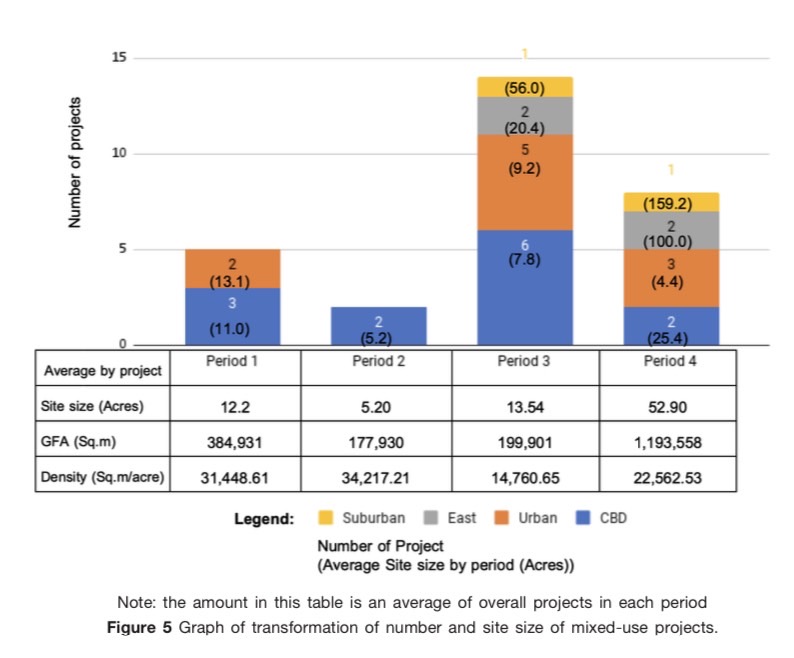Transformative Physical Attribution of Mixed-use Project Development in Bangkok Metropolitan Area, Thailand
Main Article Content
Abstract
Mixed-use developments encompass both large-scale and mega projects, strategically located in various zones including the inner city, central business district, as well as suburban and nearby areas. These projects serve as critical indicators of the prevailing direction of urban development in the region. While the underlying concept of mixed-use project development is grounded in the principles of sustainability and the enhancement of overall quality of life within the urban environment, it is essential to underscore that these projects do not operate in isolation. They exist within the broader context of the pre-existing urban landscape and are intertwined with the local communities in which they are situated. The aim of this study is to examine transformative changes of uses in mixed-use projects within the Bangkok Metropolitan area, Thailand. These changes involve the attributes and coordination among different uses within the projects. The chronological study undertaken in this research employs a methodological approach aimed at unveiling the historical evolution and prevailing trends in the development of mixed-use projects. The research findings indicate a discernible pattern wherein a majority of these projects have expanded from the city center towards suburban and outlying areas. These suburban areas are notably targeted for future urban development initiatives. Importantly, these areas continue to maintain medium to high population densities and include zones designated for residential and industrial purposes, which in turn have substantial implications for land pricing and investment strategies. Considering these findings, urban planners are presented with a valuable opportunity to proactively prepare and adapt city planning strategies to align with this transformational shift in urban development patterns. Such proactive measures are essential to ensure that the city’s growth and development remain sustainable, balanced, and responsive to the changing needs and dynamics of its residents and stakeholders.
Downloads
Article Details

This work is licensed under a Creative Commons Attribution-NonCommercial-NoDerivatives 4.0 International License.
All material is licensed under the terms of the Creative Commons Attribution 4.0 International (CC-BY-NC-ND 4.0) License, unless otherwise stated. As such, authors are free to share, copy, and redistribute the material in any medium or format. The authors must give appropriate credit, provide a link to the license, and indicate if changes were made. The authors may do so in any reasonable manner, but not in any way that suggests the licensor endorses you or your use. The authors may not use the material for commercial purposes. If the authors remix, transform, or build upon the material, they may not distribute the modified material, unless permission is obtained from JARS. Final, accepted versions of the paper may be posted on third party repositories, provided appropriate acknowledgement to the original source is clearly noted.
References
Blackson, H. (2012). Don’t get mixed up on mixed use. Placeshakers.Wordpress. https://placeshakers.wordpress.com/2012/07/05/dont-get-mixed-up-on-mixed-use/
CB Richard Ellis. (2018). Bangkok property market quarterly presentation Q3 2017. Google. https://www.google.com/url?sa=t&rct=j&q=&esrc=s&source=web&cd=&cad=rja&uact=8&ved=2ahUKEwjQjs_F2JSEAxVfd2wGHYatBCAQFnoECBAQAQ&url=https%3A%2F%2Fmembers.bccthai.com%2Fasp%2Fview_doc.asp%3FDocCID%3D3264&usg=AOvVaw15FkgakRjCfkW6HQDenHoM&opi=89978449
Cheah, CYJ., & Tan, KS. (2005, October 16-19). Mixed-use project development process: Features, pitfalls and comparisons with single-use projects. [Paper presentation]. 1st International Conference on Comstruction Engineering and Management (ICCEM), Seoul, Korea.
DDProperty. (2020). DDproperty property market outlook 2020. https://www.ddproperty.com/insights/ddproperty-property-market-outlook-2020-2-556
Grant, J.L. (2002). Mixed use in theory and practice: Canadian experience with implementing a planning principle.
Journal of the American Planning Association, 68, 71 - 84.
ICONSIAM.(2023). What do you need to know about ICONSIAM in 5 minutes. https://www.iconsiam.com/en/the_stories/content-id-f130b680-e315-11e8-bddc-fb70105a463b
Jacobs, J. (1961). The death and life of Great American cities. Vintage Books.
Klinmalai, S. (2014). Effect evaluation of gated housing projects accumulated in suburban residential areas of Bangkok metropolitan region. Kyoto University.
Kitika, C. (2020). New feature of mixed-use design on public area: Case studies from Chang Phuak Road to Moon Muang Soi 7, Chiang Mai Thailand. Journal of Architectural/Planning Research and Studies, 17, 137-156
Levitt, R. L. (2003). Mixed-use development handbook. Urban Land Institute.
NAIOP Research Foundation. (2007). Mixed-use development: A review of professional literature. https://www.naiop.org/globalassets/research-and-publications/report/an-analysis-of-the-feasibility-of-mixed-use-development/researchreportfeasibilitymixedusedevelopment.pdf
Niemira, MP. (2007). The concept and drivers of mixed-use development: Insights from a cross-organizational membership survey. Research Review, 4(1), 54.
Punson, B., & Pokharatsiri, J. (2023). A land use approach to promote Charoenkrung district as a creative industry hub - possibilities under the Bangkok comprehensive plan. Journal of Architectural/Planning Research and Studies, 21, 41-62 .
Real Estate Information Center. (2023). Survey of mixed-use projects in Bangkok metropolitan region in 4th quarter of 2023.
Salmi, A. (2010). Collective case studies and research process - How do research teams tackle the dynamics?. In, 26th Industrial Marketing and Purchasing Conference (IMP) (pp. 2-4). Industrial Marketing and Purchasing Group (IMP).
Sapsangthong, A., Horayangkura, V., & Dokoska, A. (2021). Planned Unit Development (PUD) in urban design project. Journal of Architectural/Planning Research and Studies, 18, 41-52 .
The Cluster of Logistics and Rail Engineering, Faculty of Engineering, Mahidol University. (2022). Bangkok
Mass Transit system updated 2022 / Version BKK 1.1 / 27 Jan 2022. Mass Rapid Transit Authority of Thailand. https://www.mrta.co.th/th/news-release/10181
Thai Real Estate Association. (2020, March 27). Sāmsip pī thī phān mā ʻō̜ sang hā Thai phān ʻarai mābāng?[What has the Thai real estate sector gone through in the past 30 years?].Thairealestate. https://thairealestate.org/content/detail/726/30-ปีที่ผ่านมา-อสังหาฯ-ไทยผ่านอะไรมาบ้าง
Urban Land Institute. (1987). Community builder handbook series: Mixed-use development handbook. Second Print.
Yuttharsaknukul, P. (2020). Mixed-use projects bringing both opportunities and risks to the commercial real estate rental industry. SCBEIC. https://www.scbeic.com/th/detail/product/6525


